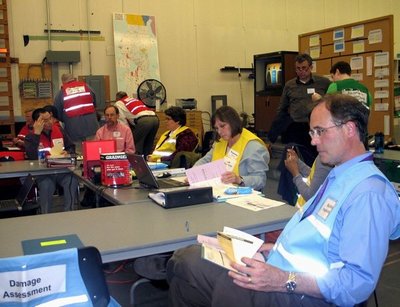May 7, 2009
Emergency procedures practiced, evaluated in Operation Crash Start disaster drill
If an emergency occurs on campus, how will the UW respond?
Representatives of a number of campus departments gathered at the UW Emergency Operations Center (EOC) in the Bryant Building on Thursday, April 30, to study that question in an afternoon-long disaster drill called Operation Crash Start.
On hand were folks from the UW Police, Facilities Services, Health Sciences, UW Medical Center, Hall Health, UW Technology, Student Life, Transportation Services, Capital Projects, News & Information, Risk Management, Human Resources, Environmental Health & Safety and Purchasing Services, and many other campus units.
Such drills, put on by Steve Charvat and his colleagues in UW Emergency Management, have been an annual occurrence since 2004. They have ranged from “tabletop” exercises to full-on disaster simulations, about mock earthquakes, pandemics and other emergencies.
Thursday’s drill was of the tabletop variety. Participants examined and discussed a disaster scenario in a real-time format over the course of an afternoon, with more learned in successive “storyboards,” or reports from campus. Charvat urged participants to discuss possible responses in an open and unguarded way. “We are all equals in here,” he said. “Nothing is confidential.”
The imagined disaster for the drill was one that started out bad and quickly got a lot worse. In the scenario, a commercial airliner fell from the sky and crashed into Kane Hall, destroying that building and causing fires in nearby buildings. Later, a second plane — a small private aircraft — smashed into nearby Savery Hall. Making matters much worse in this simulation was the additional challenge that the smaller plane carried a canister of the Ebola virus.
As the afternoon went on, participants discussed what they would do, and in what order, if such a disaster were to strike.
Charvat early on described the drill’s five main objectives:
- to practice the real-time notification system for UW emergency responders,
- to review decision-making procedures at the EOC,
- to practice EOC shift-change protocol,
- to integrate senior UW leadership in the EOC decision-making process,
- to adapt to using paper forms for messages and to document the drill for future administrative needs.
Afterward, Charvat said the drill succeeded in familiarizing new people to the EOC and its workings and getting them to understand and use the decision-making process. “Also, the scenario was one we’d never dealt with before. We’ve done the flu and explosions — it’s good to mix things up.”
The drill, planned months in advance, was unrelated to the current swine flu epidemic. Coincidentally, the drill took place the day after the federal government reacted to the growing swine flu epidemic by raising the “influenza pandemic alert” from Phase 4 to an unprecedented Phase 5.
Next came the “after-action report” that serves as a critique of afternoon’s activities, from participants and evaluators alike. Charvat jokingly calls this report “the good, the bad and the ugly.” This was sent out Monday to everyone on the EOC call-out list, even if they didn’t participate in the drill. “We’ll emphasize the things that worked well and the things that need improvement,” Charvat said.
The reviewing stage will continue this week, with participants meeting to discuss the drill from 10 to 11:30 a.m. Friday, May 8, in 142 Gerberding.
And though Operation Crash Start is over, emergency planning continues every day at the UW. Click here to learn more.



